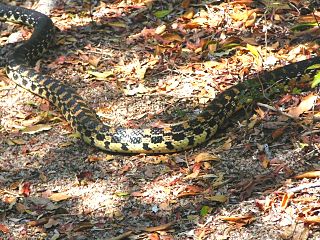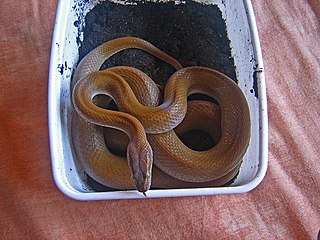
George Albert Boulenger was a Belgian-British zoologist who described and gave scientific names to over 2,000 new animal species, chiefly fish, reptiles, and amphibians. Boulenger was also an active botanist during the last 30 years of his life, especially in the study of roses.

Lamprophis is a genus of medium-sized, nonvenomous snakes commonly referred to as African house snakes, in the family Lamprophiidae.
Chamaelycus is a genus of snakes, commonly referred to as banded snakes, in the family Lamprophiidae. The genus is endemic to Central Africa.
Gonionotophis is a genus of snakes, known commonly as African ground snakes and file snakes, in the family Lamprophiidae. The genus is endemic to Central Africa.
Mehelya is a genus name of snakes native to Africa. Some species formerly assigned to the genus Mehelya are now found in the genera Gonionotophis, Gracililima, or Limaformosa. They are collectively called file snakes due to their unusual scalation. They are not venomous.

Lycodonomorphus is a genus of snakes commonly referred to as African water snakes. They are small, nonvenomous snakes, with all members being endemic to Africa, especially Tanzania.
Micrelaps vaillanti, also known commonly as the black-headed micrelaps or the Somali two-headed snake, is a species of mildly venomous rear-fanged snake in the family Lamprophiidae. The species is endemic to Africa.
Aparallactus werneri, or the Usambara centipede-eater, is a species of mildly venomous rear-fanged snake in the family Lamprophiidae. The species is endemic to Tanzania.

The Cape file snake is a species of large, non-venomous snake endemic to Africa, belonging to the family Lamprophiidae.

Leioheterodon geayi, commonly known as Geay's hognose snake, the Madagascan speckled hognose snake, and the speckled hognose snake, is a species of mildly venomous snake in the family Lamprophiidae. The species is native to southwestern Madagascar.

The Lamprophiidae are a family of snakes found throughout much of Africa, including Seychelles. There are 89 species as of July 2022.
Alluaudina is a genus of harmless snakes in the family Pseudoxyrhophiidae. The genus is endemic to the island of Madagascar.

Plagiopholis is a genus of snakes in the family Colubridae. The genus is native to Asia.

Hemirhagerrhis is a genus of snakes in the family Psammophiidae.

Compsophis is a genus of harmless snakes in the family Pseudoxyrhophiidae. The genus is found only on the island of Madagascar.

Prosymna is a genus of elapoid snake. It is the only genus in the family Prosymnidae. They were formerly placed as a subfamily of the Lamprophiidae, but have been more recently identified as a distinct family.

Lamprophiinae is a subfamily of lamprophiid snakes, a large group of mostly African snakes, most of which were formerly classified as colubrids but which we now know are actually more closely related to elapids.
Hydrablabes is a genus of snakes in the subfamily Natricinae of the family Colubridae. The genus contains two species.

The black file snake, also known commonly as the dwarf file snake or the Nyassa file snake, is a species of snake in the subfamily Lamprophiinae of the family Lamprophiidae. The species is endemic to Africa.












